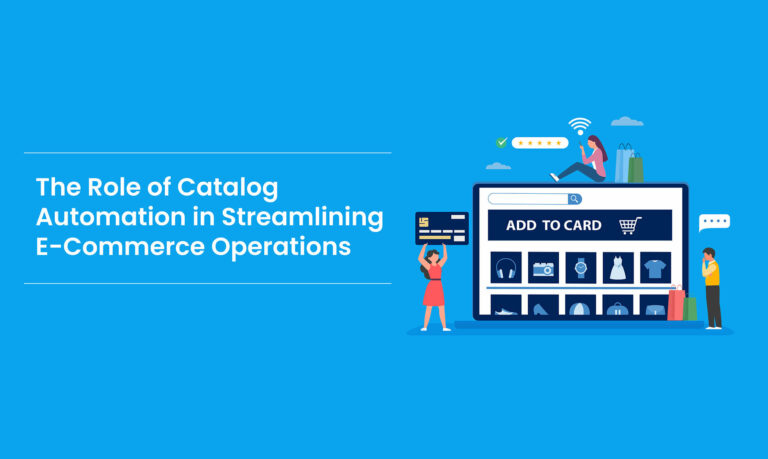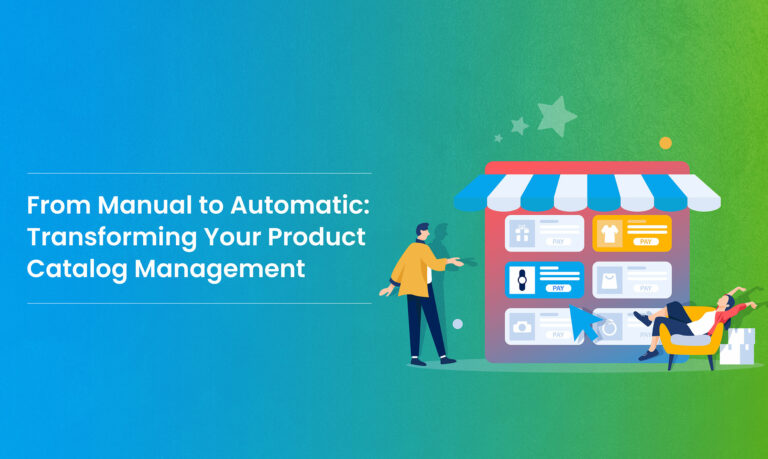Introduction
Did you know that 80% of shoppers research online before purchasing? You cannot be successful with a mere e-commerce platform to facilitate purchases. It matters if you provide a well-packed, up-to-date, and valued product catalog. Only effective product catalog management provides a seamless customer experience across all channels.
But, as your business scales, manual cataloging becomes a bottleneck. Cataloging automation by pioneers like Rubick.ai can be your magic wand to manage end-to-end cataloging and provide a unified customer experience. This blog explores the benefits of cataloging automation for your organization.
What are the Complexities of Catalog Management?
Product catalogs influence customer purchase decisions. The product description and images affect the rate of returns, cart abandonment, and brand trust. Some challenges of manual or poor cataloging are as follows:
Delay in Product On-boarding
Launching new product lines every month necessitates instant availability across diverse online channels. On-boarding new products or taking them offline to online can be overwhelming and time-consuming for your organization.
Manual Cataloging is Error-prone
Traditional cataloging methods are tedious and time-consuming, where human fatigue caps accuracy. Organizations without automated cataloging suffer from data inaccuracy while missing intricate details in product catalogs. A decline in data consistency can impact customer experience and indirectly affect your organization’s sales statistics/revenue.
Lack of Real-time Visibility
The absence of inventory insights is the widening gap between demand and supply. Poor cataloging can lead to poor inventory forecasting and increase operating costs.
Low Product Visibility
Inconsistent and poor-quality product listings can lead to low product visibility and make them invisible to potential buyers. A lack of standard catalogs can tarnish the brand image and increase cart abandonment.
Why Implement Cataloging Automation in Your Organization?
An inaccurate search result can lure customers to other market retailers, erode the brand’s credibility, and decrease sales. Today’s impatient customers need smooth going, precise, to the point and navigation-friendly catalogs. Swiping through digital catalogs with accurate information can offer intuitive navigation and increase the chances of customer purchase. Some key needs that automated cataloging solutions fulfill are:
- Automated product tagging can help in inventory classification. Also, automation can identify missing product attributes and data discrepancies/ inconsistencies.
- Catalog optimization can increase product visibility and enhance accuracy across multiple channels.
- Using automation to create, manage, and organize product catalogs can gauge product stock better, enabling retailers to monitor real-time customer demands.
- Cataloging automation provides high-quality and unified product information at a scale in warp speed and aids in effective e-commerce catalog management.
- Catalog automation can reduce the risk of inventory mismanagement, overselling, and stockout scenarios.
- Also, automated cataloging solutions can reduce bounce rates and offer a better customer experience.
Strategic Advantages of Cataloging Automation
Cataloging automation has many advantages, from quick product listing across all channels to faster time-to-market. Cataloging automation can be a boon to e-commerce organizations in the following ways:
Break Free from Data Silos
Cataloging Automation provides seamless data integration with existing ERP/CRM. AI-powered catalogs ensure cohesive and well-synchronized product information across multiple channels. Also, multichannel integration broadens the client base and improves the organization’s market share.
Price Optimization
Cataloging automation offers compelling prices with changing market patterns, rival pricing strategies, and demand variations. Extensive product assortments can benefit from AI catalogs that adapt their real-time prices to optimize earnings and elevate the organization’s sales potential. Dynamic pricing tactics can serve as a critical value proposition and give a competitive edge in the e-commerce sector.
SEO and Digital Visibility
Automated cataloging adds relevant tags and matches the attribute labels. SEO-based product listings with targeted keywords lead to more hits, higher rankings, and search engine conversions. Catalog optimization establishes brand authority and boosts online sales.
Insight-Driven Decision-Making
The power of machine learning allows studying consumer behavior, individual preferences, and past product performance. The various customer-segmented or regional layers in cataloging automation help capture and analyze shifting consumer trends, highlighting strategic breakthroughs. Organizations can benefit from data-driven decision-making, while real-time patterns lower overproduction/product wastage, leading to higher sales and market share.
Inventory Control and Customer Satisfaction
Lack of real-time visibility into real-time inventory leads to the misallocation of resources and poor forecasting, affecting delivery efficiency. Accurately tagged products from catalog optimization solutions can help in smart merchandising and attune to customer demands. Automated catalog management with real-time inventory insights can eliminate stockouts and overselling. Improved order fulfillment rates and customer satisfaction from fine-tuned product catalogs lead to operational excellence and revenue generation.
Enhanced User Experience through NLP
NLP-powered voice searches or autonomous generation of authentic product descriptions can increase customer shopping convenience and enhance user experience. Automated cataloging analyzes product information, including titles, images, and reviews, streamlining the time-consuming process of drafting manual product descriptions.
Power of Personalization
Catalog optimization solutions personalize the product pages and search results, catering to customer requirements. Online recommendations during their checkout process increase average order size, engaging customers. Cost-effective marketing campaigns with precise product data and tailored suggestions can maintain profitability. Actionable insights from automated solutions can optimize ad spend and campaign outcomes. The opportunities to up-sell and conduct promotional campaigns with customers’ unique preferences push sales figures while increasing organizational ROI.
Catalog Quality Management
Poor product accuracy increases the likelihood of returns and lowers consumer satisfaction. Automated tools and technologies help create error-free catalogs, removing duplicacies and inconsistencies. It ensures quality catalog management while maximizing online retail success. Consistent product information from catalog optimization solutions across all channels enhances brand impression and increases sales.
Seamless Navigation and Improved User Experience
Cataloging solutions create well-structured product catalogs with sufficient filters for easy navigation. Cataloging automation makes the customer journey smooth and product discovery easy, influencing purchase decisions.
Gain Market Dominance
E-commerce companies are in the race to leverage tech to identify strategic opportunities and increase revenue. Cataloging automation with intelligent customer segmentation, improved data analytics, enhanced user experience, actionable marketing insights, competitor analysis, and dynamic pricing can provide long-term competitive advantage. Organizations with automated catalog solutions can become market leaders and generate higher revenue.
Catalog Optimization solutions help to streamline operations, enhance accuracy, accelerate decision-making, and foster collaboration while making organizations thrive in today’s competitive landscape.
Best Practices for Catalog Optimization
Do you want to future-proof the cataloging process or break free from manual cataloging bottlenecks? Follow the below best practices to navigate the catalog management challenges, increase operational efficiency, and boost e-commerce sales:
- Always ensure real-time product updates by removing out-of-stock items and maintaining band credibility. Leverage automated cataloging solutions to aid in product acquisition.
- Update standardized product images online with proper light adjustments and comply with the product information to improve e-commerce sales opportunities. Proper image quality and formatting lead to an increase in average order value and seamless customer experience.
- Have a centralized data repository with product inventory, shipping, and handling information. It can improve productivity by providing a single interface for product addition, update, and removal.
- Maintain product accuracy and consistency to increase customer willingness to buy. High-quality product listings with recommendations can lead to more sales.
- Map customer journey with attributes like expectations, requirements, and pain points across multiple touchpoints with targeted marketing campaigns for a high conversion rate.
- Embrace SEO in digital catalogs with appropriate keywords for easy product discovery, increased traffic, and enhanced customer experience. Remember to include mobile-friendly digital catalogs for easy navigation.
- Invest in cataloging automation solutions with advanced tech and NLP for seamless cataloging and elevate sales potential. Such automated solutions automatically detect data inaccuracies and inconsistencies. Also, catalog optimization solutions can aid organizations with strategic breakthroughs while capitalizing on revenue.
Wrapping Up
A comprehensive and accurate product catalog can make or break the e-commerce success. With business expansion, managing the product catalogs to the level of specificity the customer wants is critical to maintaining brand loyalty. Organizations that leverage catalog optimization solutions engage customers, maintain brand reputation, elevate customer experience, and drive sales.
Cataloging automation with experts like Rubick.ai can help you become a market leader amid companies vying for dominance in the e-commerce landscape. Book a demo session today to take charge of your e-commerce catalog management.

